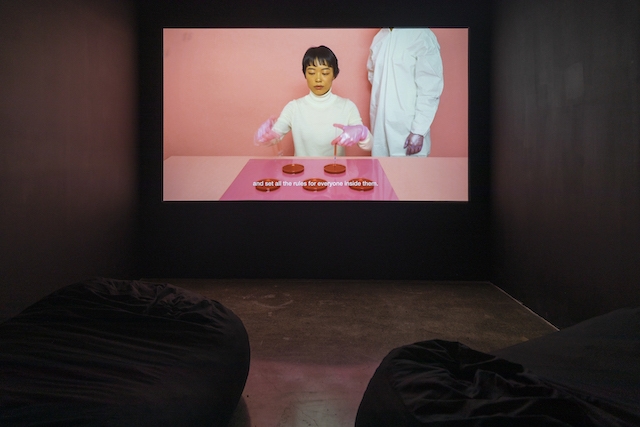In a former Detroit brewery, I have a rare experience of joy. I am half-submerged in a bed of black beans, surrounded by Mylar emergency blankets tented like a golden crown, feeling the tension drain out of my body. Fannie Sosa and Navild Acosta’s installation Black Power Naps: Black Bean Bed and Altar to the Ancestors (2018) is about racialised sleep debt, or the unequal distribution of sleep among different populations: the whiter and wealthier you are, the better you sleep at night. Alongside is a small altar and an accompanying zine with pieces on sleep equity and rest as reparations; the artists have requested, through wall text, that only persons of colour take copies.
The installation is part of Sick Time, Sleepy Time, Crip Time: Against Capitalism’s Temporal Bullying, curated by Taraneh Fazeli and housed at Red Bull Arts Detroit. This is the fourth iteration of a show that has travelled to Omaha, St Louis, Houston and New York. I am there to attend an exhibition closing that functions – given how the show experiments with duration and the fact that Fazeli’s residency at the noncommercial space is ongoing – more like a midpoint in the project.
There is a concerted effort to return to the etymological roots of curating as care work
The exhibition begins one floor underground, where visitors encounter Carolyn Lazard’s video CRIP TIME. (2018). Here, against an embroidered tablecloth, a pair of disembodied hands methodically sort medication into seven colourful dosage containers, each of which is subdivided into morning, noon, evening and bedtime. The process is accompanied by little ASMR-y clinks and pops, and robust closed captioning that annotates things like ‘(another breath is taken)’. It effectively introduces the major concerns of the exhibition: time marked by sickness and sickness marked by time; exploitation and accessibility; care and community.
Jen Liu’s extremely pink video Pink Slime Caesar Shift (2018) is screened in a womblike, beanbag-strewn side room. The work speculates a project in which bovine stem cells are altered, embedding syndicalist messages in DNA in order to secretly communicate with female factory workers in China. Animated sequences and wearables emphasise the links between labour and time even as the piece alludes to various forms of medical research and gene therapy. It’s occasionally heavy-handed, in the deployment of an instrumental version of The Internationale that spills out into the rest of the exhibition at regular intervals. This form of solidarity is faintly discomforting, presented on behalf of, as opposed to with, others.
Elsewhere, Park McArthur and Constantina Zavitsanos’s Score for Before (Scores for Two or More) (2013) pairs sculptural grab-bars with a wall text instructing the reader how to back a wheelchair up a ramp, while Jordan Lord’s poignant filmic treatise about undergoing open heart surgery emphasises the often-invisible collective labour of caretaking, using the scopic access of medical imaging technologies to speak to a broader lack of access for disabled populations (After… After…(Access), 2018). Captioning is especially descriptive here, functioning like alt text on Instagram. This is paralleled in the show’s online documentation: for example, the website text accompanying a still from Lord’s video reads, ‘At the bottom of the frame, an open caption appears over a black bar that reads: “the frame is filled by a blanket that moves up and down with my heartbeat”.’
The heart of the exhibition is its mimetic ‘Waiting Room’, replete with nondescript purple chairs, potted plants, a water cooler and magazine racks filled with radical publications emphasising the self-determination of care. The installation hosts a number of other commissions, including a food justice-themed Feed the People (c. 2013) colouring book by former Black Panther Wayne Curtis, who now runs a community garden. On the walls are posters advertising Cassie Thornton’s long-running project Give Me Cred! (2013–), which here takes the form of an alternative credit report workshop held at the local library in the weeks after the show closes. Sosa and Acosta’s Black Power Naps will also have an extended run as part of Fazeli’s programming series in the spring, which moves the show into offsite community spaces.

“With autoimmune diseases, the body doesn’t know where to begin and end,” Fazeli says in a filmed lecture that plays on a small monitor opposite Katya Tepper’s beguiling mixed-media sculptures-cum-wall-drawings, which illustrate this metaphor of the porous body. The exhibition’s boundaries were equally leaky. Its rigour and generosity suggest a show honed through years of conversation – Fazeli and several of the artists are members of Canaries, a collective of cis women, nonbinary and trans artists living with chronic illnesses and autoimmune conditions. But there is a sense that the artworks are incidental beyond their status as necessary byproducts of an institutional transaction and inseparable from their role as supports for a broader curatorial project.
There is a concerted effort to return to the etymological roots of curating as care work, not just as cute metaphor but to leverage personal and institutional prestige to effect material change. One of Fazeli’s major undertakings is into the fabric of the institution itself, working with local disability consultants Detroit Disability Power to permanently make the site more accessible (interventions range in scale from installing an external ramp to providing scent-free soap in the bathrooms). Most interesting is her strategy of hardcoding these improvements into the curatorial budget so as to ensure that they are an institutional priority. Accessibility is an “interesting lens” through which to see Detroit, Fazeli told the assembled press. So it was, for a city whose recent history has been characterised by extreme disparities in access, to both real estate and care.
Sick Time, Sleepy Time, Crip Time: Against Capitalism’s Temporal Bullying, Red Bull Arts Detroit, 18 September – 3 November 2019
From the March 2020 issue of ArtReview
